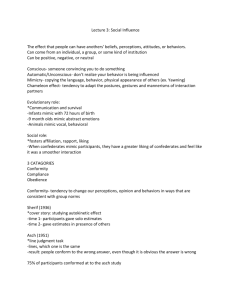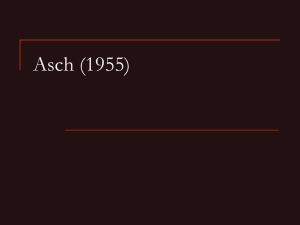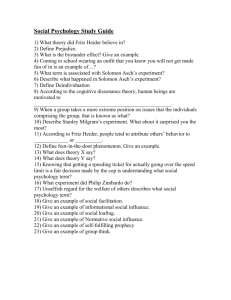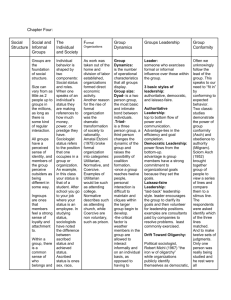Asch, SE (1955). Opinions and social pressure. Scientific
advertisement
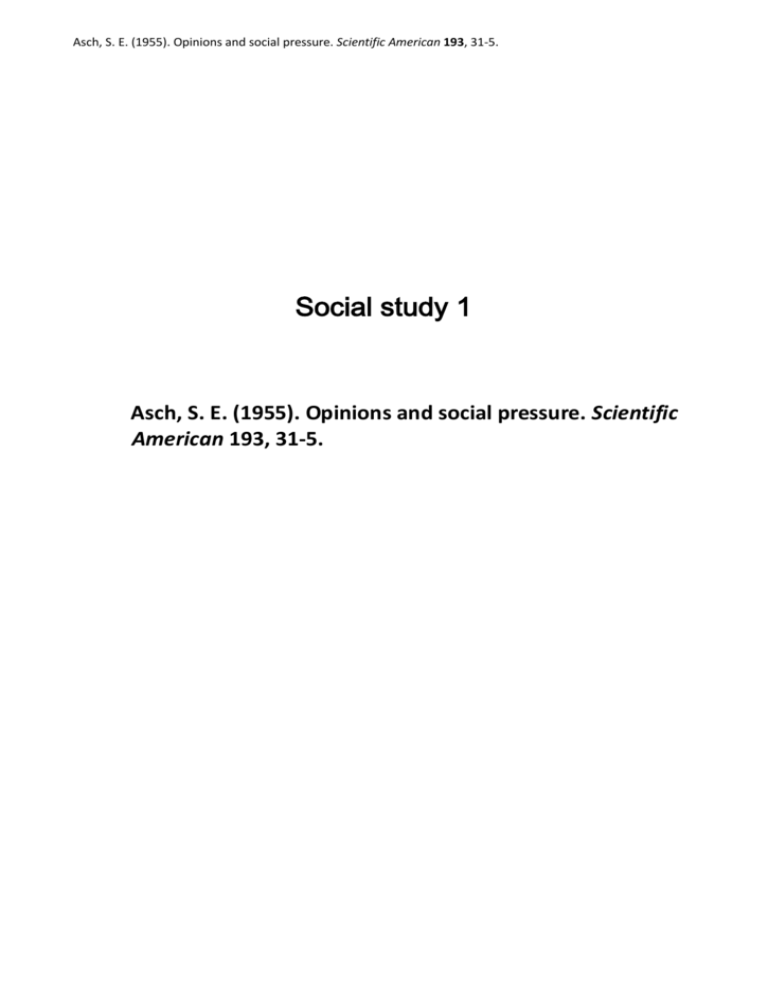
Asch, S. E. (1955). Opinions and social pressure. Scientific American 193, 31-5. Social study 1 Asch, S. E. (1955). Opinions and social pressure. Scientific American 193, 31-5. Asch, S. E. (1955). Opinions and social pressure. Scientific American 193, 31-5. Asch, S. E. (1955). Opinions and social pressure. Scientific American 193, 31-5. Aims & Context Context Asch believed that our beliefs and judgements are influenced by the groups we are in. Asch used the example of cannibalism to illustrate this. Exercise: How do you feel about cannibalism? …................................................................................................................ What do you think someone might feel about it if they grew up among cannibals? …................................................................................................................ Based on this idea Asch was interested in investigating further the extent to which people conform to social pressure from a group to adopt particular beliefs. Asch believed that it was particularly important to understand the processes of influencing people's beliefs in the 1950s for two reasons: Exercise: suggest what these might have been. 1............................................................................................................................ .............................................................................................................................. 2............................................................................................................................ .............................................................................................................................. Early social experiments had demonstrated where there was no clear answer to a question (eg. how many beans there were in a jar?) people's answers would shift towards those of people around them. However previous studies had not tested whether people could be influenced to the extent of going along with a clearly wrong answer. Aims The main aim of the study was to investigate whether an individual would conform to a group belief when that group belief was clearly incorrect. In this case the task was to identify which of three lines was the same length as another line. Group size – varied from 1-15 people The presence of a 'truthful partner' who did not conform to the group answer The presence of a partner who did not conform to the group answer or the correct answer The presence of a partner who initially gave the correct answers then began to give the same answers as the group The presence of a partner who had to leave part-way through the procedure Asch, S. E. (1955). Opinions and social pressure. Scientific American 193, 31-5. Procedure Participants 123 male student volunteers from four American universities took part in the study. They joined a group of 6-8 young men sitting around a table. The task The group was given a task in which they had to match the length of a line with one of three alternatives. They were briefed that this was a study of visual perception. Only one member of each group was a real participant (technically they are called a naïve participant). The others were stooges working for Asch. The naïve participant was seated so that he was asked last or close to last so that he would hear the answers of the rest of the group before giving his own. Each group member was asked to say in turn which of the three lines matched the length of the target line. This was meant to be easy. The control condition: In a control condition the stooges always identified the correct lines. This was to ensure that any mistakes made by the naïve participants were due to conformity effects and not difficulty in the task. The experimental condition: In the first two trials of the experimental condition the stooges identified the correct line as did the naïve participant. However in the third trial the stooges all identified the incorrect line. The idea was to see whether the naïve participant would conform to the majority view or name the correct line in defiance of the group. If the naïve participant turned out at this point to be not so naïve, and realised they were being manipulated, the experiment was stopped. Each participant took part in 18 trials and in 12 of them the stooges named an incorrect line. Variations from the basic procedure Group size was varied so that the naïve participant was with between one and fifteen stooges A 'truthful partner' who did not conform to the group answer was placed among the stooges A partner who did not conform to the group answer or the correct answer but gave a different incorrect answer was placed among the stooges A partner was placed among the stooges who initially gave the correct answers but who then began to give the same answers as the rest of group A partner who gave the correct answers was placed among the stooges but he had to leave for an appointment Asch, S. E. (1955). Opinions and social pressure. Scientific American 193, 31-5. Findings & conclusion Headline figures In the control condition in which stooges identified the correct line each time the naïve participants succeeded in spotting it 98% of the time. In the standard experimental condition where the group identified a different line this dropped dramatically to 63.2%. In other words participants conformed to a blatantly wrong group belief over a third of the time. Exercise: fill in the headline figures in the table below % identifying correct line Experimental condition Control condition The effect of group size The size of the majority group also made a difference. In particular when the group was very small, rates of conformity dropped. The graph below shows the percentage of participants identifying the wrong line in different sized groups. Once the size of the group reached three the effects of increasing its size became much smaller. The effect of a partner The presence of the truthful partner raised the correct responses to 75%. Partners who disagreed with both the majority of the group and the correct answer had a more complex effect. When they chose a line slightly different in length to the correct one they moderately increased the percentage of correct responses from the participant. When however they chose the line most obviously different from the correct one participants chose the correct line 91% of the time. Having a partner who gradually began to give wrong answers like those of the rest of the group was no different to the basic condition in which they gave the wrong answer all along – around a third of the naïve participant's answers were inaccurate. Where the supportive partner had to leave rather than changing sides the effect was smaller. Conclusions Is conformity a powerful influence on behaviour? Yes [ ] No [ ] Are conformity effects greatest in small or large groups? Small [ ] Large [ ] Is conformity easier to resist with a partner? Overall did people usually conform? Yes [ ] Yes [ ] No [ ] No [ ] Asch noted that although conformity was a worrying part of human nature people did not usually conform to social pressure to choose a blatantly wrong option. He thus remained optimistic about people's ability to resist conformity. Evaluating the methodology Asch, S. E. (1955). Opinions and social pressure. Scientific American 193, 31-5. Identify some strengths and two weaknesses of Asch's methodology by writing very briefly in whichever of the boxes below seem relevant to this study. Now identify what you think are the key strengths and weaknesses (ideally 2 of each but not necessarily) ….......................................................................................................................... .............................................................................................................................. .............................................................................................................................. .............................................................................................................................. .............................................................................................................................. .............................................................................................................................. .............................................................................................................................. .............................................................................................................................. .............................................................................................................................. Asch, S. E. (1955). Opinions and social pressure. Scientific American 193, 31-5. Alternative evidence Do modern studies show conformity? Have you ever watched a show featuring a panel of judges – like The X-Factor or Strictly Come Dancing – and wondered whether each judge is influenced by the judgements the others have made? A study Boen et al (2006) may shed some light on this. 27 judges were divided into panels of up to five and asked to judge the same 30 videotaped skipping performances. In one condition the judges were aware of each other’s judgements and in the other they were not. There was significantly more agreement when they heard each other’s feedback, suggesting that they did tend to conform to the judgement of the rest of the panel. Exercise: does the Boen et al study support Asch? Explain why. …........................................................................................................................... .............................................................................................................................. .............................................................................................................................. …........................................................................................................................... Are we still as conformist now as people in 1950s America? Whenever we look at studies carried out in a particular historical period and one culture we need to ask ourselves whether similar results would be found in a different time and place. Perrin & Spencer (1980, 1981) repeated Asch's procedure in Britain using science students and youth offenders. They found high levels of conformity in the offenders but not in the students. Exercise: do the Perrin & Spencer studies support Asch? Explain why. …........................................................................................................................... .............................................................................................................................. .............................................................................................................................. …........................................................................................................................... Asch, S. E. (1955). Opinions and social pressure. Scientific American 193, 31-5. Is conformity culture-specific? Asch himself wondered whether conformity is culture-specific ie. Is it part of all human nature or just a product of certain societies? This was addressed in a meta-analysis by Bond & Smith (1996) of conformity studies carried out in different countries. Meta-analysis involves combining the results of smaller studies in order to analyse a large sample size. This particular analysis involved the results of studies comparing conformity in individualist and collectivist societies. Individualist societies are those, like USA and Britain, where the emphasis is on the freedom of the individual. Collectivist societies, including China, Japan and Africa place more emphasis in their culture on people’s dependence on and obligations to one another. Bond & Smith concluded that conformity is a feature of behaviour in all the societies studied. However, conformity was found to be greater in more collectivist societies. Exercise: does the Bond & Smith study support Asch? Explain your answer. …........................................................................................................................... .............................................................................................................................. .............................................................................................................................. …........................................................................................................................... Overall to what extent to later studies support Asch? This would be your conclusion in an essay on alternative evidence. …........................................................................................................................... .............................................................................................................................. .............................................................................................................................. ….......................................................................................................................... And finally........ Here are the questions you could be asked about Asch. 1. Summarise the aims and context of Asch's (1955) study. 2. Outline the procedures of Asch's (1955) study. 3. Describe the findings and conclusions of Asch's (1955) study. 4. Evaluate the methodology of Asch's (1955) study. Asch, S. E. (1955). Opinions and social pressure. Scientific American 193, 31-5. 5. With reference to alternative evidence, critically assess Asch's (1955) study.

